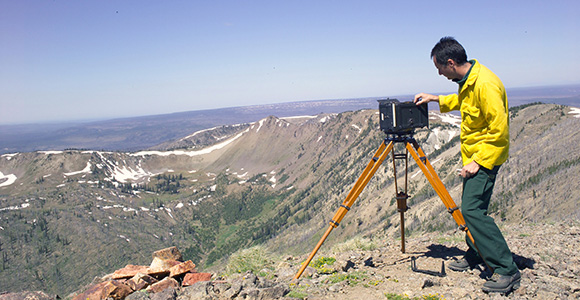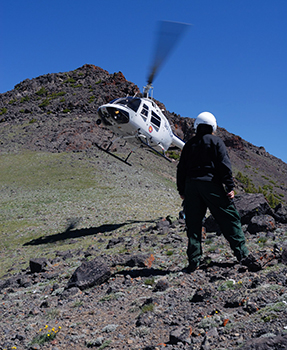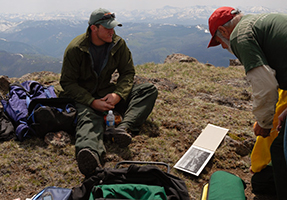It was that kind of place, because it was the exact log and the exact rock in the exact same place from 80 years earlier and it didn’t look any different at all. This had to be the same place. . . Ian Grob, Photographer

Could being the last person to walk into a class shape your future because of an event that occurred in the past? It’s an intriguing question, but after talking with Missoula, Montana-based US Forest Service employee, Ian Grob, it surely seems so.
In 2003, Ian visited the Missoula Technology Development Center (MTDC), prior to interviewing for a position there. He learned that MTDC, a US Forest Service center for engineering related to federal and state land management, had one of the Osborne cameras that had been built in the 1930s for the panoramic lookout photo project. There was a plan for staff from MTDC to go to Yellowstone National Park to retake photographs from the same points.
After accepting and starting the job, Ian attended a leadership class in Missoula. He was the last person to walk into class, and met the second to last person to walk into class, Andy Mitchell, assistant fire management officer at Yellowstone National Park. Ian and Andy sat next to one another and began to visit. The topic of the camera and the retake project came up quickly; Andy was familiar with it, as he had recently been given all the photographs taken by Lester Moe at Yellowstone. A few months later, coordinating with Yellowstone, and with funding from the National Park Service’s national office for wildland fire management, Ian was in Yellowstone ready to retake Moe’s photographs from lookout points.
Andy had given Lester Moe’s photographs to the Yellowstone archives, so to complete the project, they obtained duplicates of the images to closely match the vistas and perspectives.
Using infrared (IR) film, which required absolute darkness to change it out, was challenging. The crew used infrared film primarily to cut through any haze in the atmosphere, to produce higher contrast images of the “background,” which was the primary focus of the images. When using IR film, infrared shows up as red, red as green, and green as blue. The dyes in all three layers of IR film are sensitive to blue light, so a yellow filter, Kodak K12, was used to block all blue light from passing through the lens. A healthy forest reflects more infrared and is depicted on infrared film as bright red. An unhealthy forest, which may appear perfectly fine to the naked eye, but due to disease or stress brought on by bark beetles, reflects less infrared and shows up as a much darker magenta, orange, or yellow, depending on the makeup of the leaves or needles.

On the original project, Moe had taken photographs from lookout points at three different times of day – 9:00 a.m. shooting to the west, as the sun is rising in the east, 12:00 p.m. to take the north-facing shot, and 3:00 p.m. for the photo to the east. Ian and his team didn’t have the luxury of waiting out the weather, sometimes for days, like Moe did. “It was basically, the sky is pretty clear and we should shoot it now,” Ian said. In addition, Ian’s team was trying to shoot from one or two lookout points in a day. In some cases, they used a helicopter to move more quickly from point to point. When they did hike, carrying the 75-pound Osborne camera wasn’t easy. After more than one arduous hike to a lookout point with the camera, the clouds moved in. Ian said, “Definitely shoot them when you get the chance, because once you get to 2:00 or 3:00, the clouds roll in certain times of the year.”
The bulk of the time Ian spent on the retake project was in Yellowstone, but, he did have the opportunity to retake some photographs in Glacier National Park as well. Because he didn’t have easy access to a helicopter to reach some of the more remote photo points at Glacier, many of the retakes are from roadside points or lookouts that could be reached in a day. Glacier is also pursuing retake photography for the purposes of glacier monitoring in light of climate change.
Though he spent time at Glacier on this project, the majority of stories Ian had to tell were about Yellowstone. The worst mosquitos were on the hike to Purple Mountain, which, according to Ian, was “absolutely mosquito-infested, so all of us had a great interest to get out of there quickly.” In addition, he was able to spend time with his dad and uncle on the project. One memorable hike included fording the Snake River. “The sun wasn’t up and it was freezing, and we had to do the river crossing with a one-of-a-kind camera; maybe there are two or three working models left in the world.” They joked that if they were going to fall, it would be on the way back, “after we had gotten all the shots.”

At times, they felt like they were walking in Lester Moe’s footsteps, over ¾ of a century later. According to Ian, “I do remember there was a log down on a ledge and I thought my gosh, nothing’s changed. It was that kind of place, because it was the exact log and the exact rock in the exact same place from 80 years earlier and it didn’t look any different at all. This had to be the same place, there’s no way it’s a random freak of chance that it’s a different log; that is the exact log in this original photo. A couple others you notice big differences, but that was the one where it was, man, that’s pretty cool.”
Even though only only a few years have passed since the retake project ended, times have changed. In 2010, Kodak discontinued the production of Aerochrome III infrared film. While this does mean the project could not now be reproduced as was done in the past, large-format panchromatic film, or what someone would consider “normal” color film, is still available. However, the ability to limit haze would be greatly reduced with the IR film. Jim Kautz with the US Forest Service believes that pollution levels, especially in the western United States, were significantly lower in the 1930s than they are today. Thus “even on what appears to be a clear day, the haze we see is much worse than anything Moe had to contend with, thereby placing an even greater need to use infrared film for the retakes.”
So, what does Ian think about having been a part of this historic project? “I’m definitely thankful for all the people that helped out and that Dick [Bahr] was kind enough to fund this. I think it was the rarity of the fact that this camera exists and we could do it. That I had it at MTDC made it even better for me, I guess.”
Last updated: July 22, 2020
